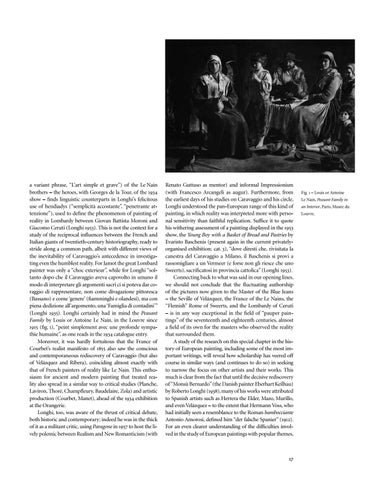a variant phrase, “L’art simple et grave”) of the Le Nain brothers – the heroes, with Georges de la Tour, of the 1934 show – finds linguistic counterparts in Longhi’s felicitous use of hendiadys (“semplicità accostante”, “penetrante attenzione”), used to define the phenomenon of painting of reality in Lombardy between Giovan Battista Moroni and Giacomo Ceruti (Longhi 1953). This is not the context for a study of the reciprocal influences between the French and Italian giants of twentieth-century historiography, ready to stride along a common path, albeit with different views of the inevitability of Caravaggio’s antecedence in investigating even the humblest reality. For Jamot the great Lombard painter was only a “choc exterieur”, while for Longhi “soltanto dopo che il Caravaggio aveva capovolto in umano il modo di interpretare gli argomenti sacri ci si poteva dar coraggio di rappresentare, non come divagazione pittoresca (Bassano) e come ‘genere’ (fiamminghi e olandesi), ma con piena dedizione all’argomento, una ‘Famiglia di contadini’” (Longhi 1935). Longhi certainly had in mind the Peasant Family by Louis or Antoine Le Nain, in the Louvre since 1915 (fig. 1), “peint simplement avec une profonde sympathie humaine”, as one reads in the 1934 catalogue entry. Moreover, it was hardly fortuitous that the France of Courbet’s realist manifesto of 1855 also saw the conscious and contemporaneous rediscovery of Caravaggio (but also of Velázquez and Ribera), coinciding almost exactly with that of French painters of reality like Le Nain. This enthusiasm for ancient and modern painting that treated reality also spread in a similar way to critical studies (Planche, Laviron, Thoré, Champfleury, Baudelaire, Zola) and artistic production (Courbet, Manet), ahead of the 1934 exhibition at the Orangerie. Longhi, too, was aware of the thrust of critical debate, both historic and contemporary; indeed he was in the thick of it as a militant critic, using Paragone in 1957 to host the lively polemic between Realism and New Romanticism (with
Renato Guttuso as mentor) and informal Impressionism (with Francesco Arcangeli as augur). Furthermore, from the earliest days of his studies on Caravaggio and his circle, Longhi understood the pan-European range of this kind of painting, in which reality was interpreted more with personal sensitivity than faithful replication. Suffice it to quote his withering assessment of a painting displayed in the 1953 show, the Young Boy with a Basket of Bread and Pastries by Evaristo Baschenis (present again in the current privatelyorganised exhibition; cat. 3), “dove diresti che, rivisitata la canestra del Caravaggio a Milano, il Baschenis si provi a rassomigliare a un Vermeer (e forse non gli riesce che uno Sweerts), sacrificatosi in provincia cattolica” (Longhi 1953). Connecting back to what was said in our opening lines, we should not conclude that the fluctuating authorship of the pictures now given to the Master of the Blue Jeans – the Seville of Velázquez, the France of the Le Nains, the “Flemish” Rome of Sweerts, and the Lombardy of Ceruti – is in any way exceptional in the field of “pauper paintings” of the seventeenth and eighteenth centuries, almost a field of its own for the masters who observed the reality that surrounded them. A study of the research on this special chapter in the history of European painting, including some of the most important writings, will reveal how scholarship has veered off course in similar ways (and continues to do so) in seeking to narrow the focus on other artists and their works. This much is clear from the fact that until the decisive rediscovery of “Monsù Bernardo” (the Danish painter Eberhart Keilhau) by Roberto Longhi (1938), many of his works were attributed to Spanish artists such as Herrera the Elder, Mazo, Murillo, and even Velázquez – to the extent that Hermann Voss, who had initially seen a resemblance to the Roman bambocciante Antonio Amorosi, defined him “der falsche Spanier” (1912). For an even clearer understanding of the difficulties involved in the study of European paintings with popular themes,
Fig. 1 – Louis or Antoine Le Nain, Peasant Family in an Interior, Paris, Musée du Louvre.
